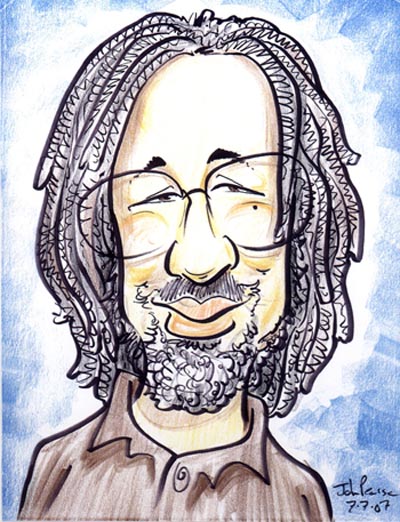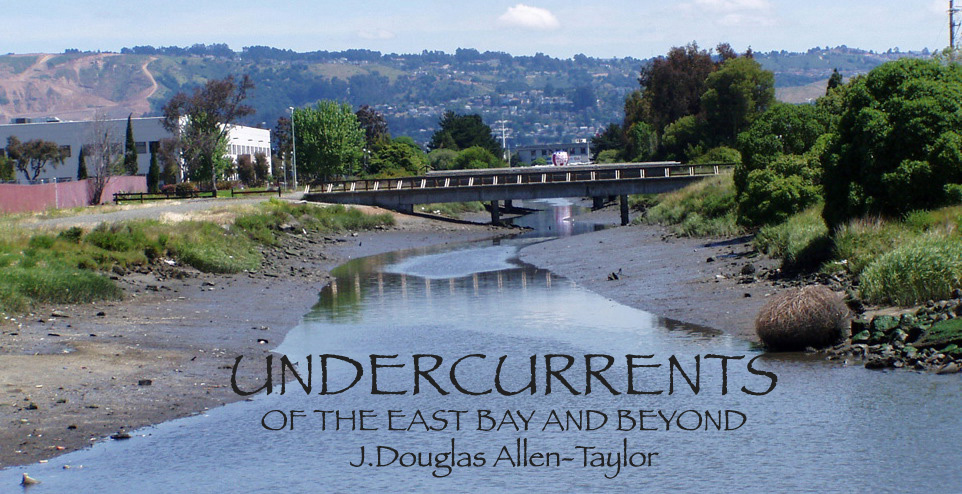|
|
GETTING OUT OF THEIR LANE
October 12 , 2007
It was a couple of throwaway sentences deep into the second page of an Oakland Tribune murder arrest story, so innocuous that if you read it, you probably hardly noticed. And that’s what makes it so insidious, why it should make us worried, and why the police practice involved ought to be brought to a halt.
The sentences in question appeared in the October 4, 2007 “Reputed Gang Member Nabbed In Killings” story in which the Tribune reported that a suspect, 26 year old Ivan O. Ordaz, had been arrested in the September 1st East Oakland shooting deaths of 19 year old Thomas Melero-Smith and 22 year old Allan Mejia Martinez.
Following the statement that Ordaz had confessed to both murders, the Tribune article added that “[Oakland homicide Sgt. Tony] Jones said Ordaz ‘was very cooperative, but emotionless’ while making his admissions. ‘He did not show any remorse,’ Jones said.”
These police statements ought to trouble us, if we are paying attention to their implications.
Saying that someone gave a confession is a statement of fact, information that is proper for the police department to release and for the Tribune to report. We presume that either the confession was video- or audio-taped or signed so that, if Mr. Ordaz at some later point says he did not confess, the police department can produce that proof.
But a statement that a person is “emotionless” or “showed no remorse” is a subjective matter. We will take Mr. Jones at his word, since we have no reason not to, and believe that the homicide sergeant listened very carefully to Mr. Ordaz and watched his movements and expressions during the police interview, honestly concluding that in his opinion, Mr. Ordaz acted as if he didn’t care about the deaths that resulted from his actions. However, because that was Mr. Jones honest observation does not make it established fact that no emotion was shown. It is entirely possible that another observer could have listened to the same interview, watched those same movements, and come to the entirely opposite conclusion, perhaps that Mr. Ordaz appeared stoic, but that was only because he was trying hard to hold back emotions of remorse that were clearly bubbling up inside. I am not suggesting that this is what happened. I was not there, during the interview, so that all I can do is take the word of the OPD homicide sergeant on it. And that is the problem.
The issue of perpetrator remorse, while it is not supposed to be considered by a jury in the guilty-innocent phase of a trial, is one of the determining factors for jury deliberations in the penalty phase of a death penalty trial. If Mr. Ordaz were to recant his confession and plead not guilty, and there were enough surrounding circumstances for the Alameda County District Attorney to seek the death penalty, the issue of Mr. Ordaz’ remorse, or lack of remorse, during his police interview would almost certainly come before the jury. And at that point, it would be proper for Mr. Jones to give his observations, since those observations would be subject to cross-examination by Mr. Ordaz’ attorney, giving the jury the opportunity to hear both sides.
In the Tribune article, however, there is only one side of the police interview of Mr. Ordaz: the police side.
The problem with the Ordaz lack-of-remorse remark by an Oakland police official is not so much that it was subjective, but that it was unnecessary, outside the lane of what police officials ought to be doing in investigating crimes, compiling evidence, and arresting suspects. And, unfortunately, some members of the Oakland Police Department appear to be making something of a habit of that, these days.
Consider the recent self-admitted OPD embarrassment in the Chauncey Bailey-Your Black Muslim Bakery case.
On September 20, in the story headlined “Bailey Gun Tied To Other Crime:” the Tribune reported that OPD officials had “confirmed” that the shotgun used to murder Chauncey Bailey on August 2 “also was used in a failed June 2005 assassination attempt on [John Bey,] a former high-ranking member of the bakery organization” and that “the same shotgun was used last December to blast out the windows of a car belonging to the ex-boyfriend of the girlfriend of Yusuf Bey IV, the now jailed leader of the bakery empire.” “Linking the shotgun to the attack on John Bey,” the Tribune continued, “is the first public confirmation of the long-held suspicion there was a fierce internal battle for control of the lucrative organization between the bakery's old guard and younger family members. Investigators suspected at the time bakery members had been involved in the attempt on John Bey's life, and when they also suspected the owner of the car in last December's attack also was targeted by bakery members, they compared the recovered shotgun shells and found a match.”
Except, in fact, none of that was true.
Two days later, “embarrassed” (their word) OPD officials admitted in a Tribune story entitled “Police Wrong About Gun In Bailey Killing” that no police criminologist had ever matched shotgun shells from the Bailey murder and the two Your Black Muslim Bakery officials shootings. “[Homicide Sgt. Lou] Cruz, the investigator who had said the shotgun was used in the three attacks, said Friday he was ‘led to believe there was a match.’” According to the Tribune story. But “after the [OPD] criminalist saw media accounts about the supposed matches Thursday, he contacted investigators and told them he never had compared the shells in Bey's case with the car shooting. On Friday, he tested the shells from all three crimes with both shotguns recovered during the raid and determined none matched the Bey attack.”
The Tribune article of September 22 focused on the self-confessed “embarrassment” of the police having to recant their original assertion of a link, but I have a different question: why did Oakland police officials feel the need to release the information about the shotgun shell link in the first place?
The Bailey murder shotgun itself, you may remember if you have followed the Bailey case closely, was discovered by Oakland police during the raid of three Your Black Muslim Bakery properties the day after Mr. Bailey was shot and killed in downtown Oakland. OPD officials have said that Bakery handyman Devaughndre Broussard threw the weapon from the window of one of the properties as police were entering, that forensic testing linked the shotgun to the shells found at the Bailey murder scene, and that Mr. Broussard himself later confessed to the murder. (The Tribune now refers to that as “tearfully” confessed. Our police department seems obsessed with telling us details of confessors’ demeanor in these cases.)
In any event, if the Bailey murder shotgun was the same weapon used in the earlier attacks on Your Black Muslim Bakery associates, which took place before police believe Mr. Broussard began his association with the Bakery, that would, indeed, provide a link between other Bakery members and the Bailey murder, a link Oakland police presumably have been trying to make.
But why was there a need to make that link of shotgun shells in the media—even if that link between the three shootings had actually proved to be correct—instead of using that information to gather enough evidence to bring further arrests in the Chauncey Bailey murder case, or arrests in the earlier two shootings at Your Black Muslim Bakery officials? That, after all, is what the police are supposed to be doing, gathering enough evidence after crimes have been committed to support an arrest.
If you believe my purpose here is to defend the murderers of Thomas Melero-Smith, Allan Mejia Martinez, and Chauncey Bailey, whether they are the persons who have already confessed, or somebody else, well, friend, you have missed the point. It’s quite the opposite. I want the perpetrators found, and anything the police do which impedes their work in finding those perpetrators—including selective leaks to the press where such leaks demonstrate no necessary public purpose—should be set aside.
One might argue that in the case of the Bailey murder shotgun, police were only being helpful in trying to keep the press and the public informed. The problem is, Oakland police are helpful in such cases when it suits them, unhelpful when it doesn’t. I have been trying for several months to get OPD records of the 30 day car confiscations they have been conducting throughout East Oakland for the past several years. OPD officials have gone before both the Oakland City Council and the California State Legislature to give details on how many such car confiscations have taken place. On the other hand, they tell me that they can’t isolate and release those records so those assertions can be verified.
Meanwhile, a week after Chauncey Bailey, I praised the Oakland Police Department for its circumspection in handling out information in the case in its initial stages. “Oakland police officials,” I wrote, “have been measured and cautious in what they have released to the press concerning the Your Black Muslim Bakery arrests. … [Assistant Oakland Police Chief Howard and Lt. Ersie Joyner have] refused to speculate beyond that, despite repeated questions by reporters, saying only that the persons arrested were being questioned, and the department was continuing its investigation. And that’s exactly how it should have been. The department satisfied the public’s need to know evidence in the Bailey murder had been uncovered—confirming the widespread speculation that there was some connection with the murder to Your Black Muslim Bakery—but refusing to participate in any public rush to judgment. … If there is enough evidence developed by police to bring to the District Attorney and a judge to take out a warrant for further arrests in the Bailey murder, then police should do so, and it is proper for them not to speculate in detail about that. Speculation don’t make it so.”
Unfortunately, at least some Oakland police officials have decided to return to the land of speculation, to their embarrassment, and to our dismay.
|

